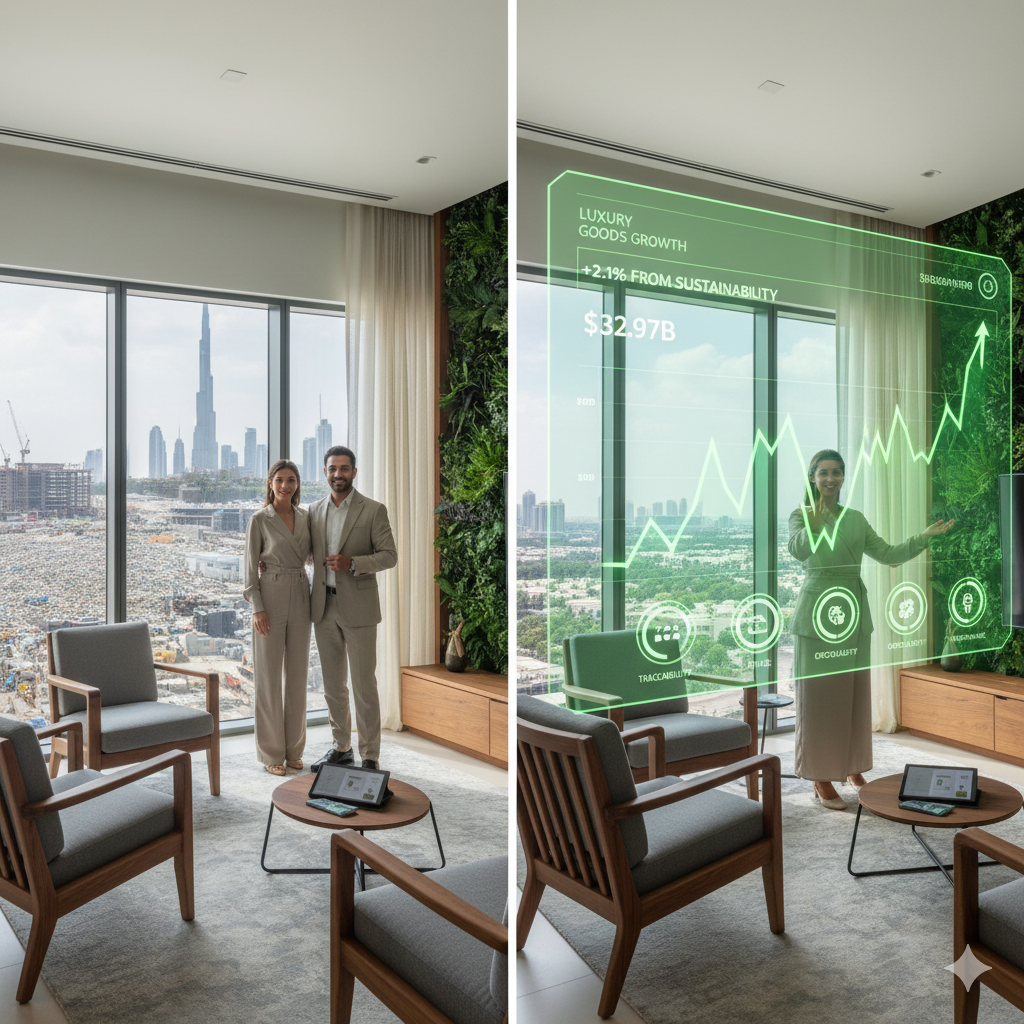The New Language of Luxury
The definition of luxury is undergoing a profound transformation. For today’s discerning global citizen, opulence is no longer measured solely by price tags or brand prestige. A new, more sophisticated calculus of value has emerged, one that weighs ethics, environmental impact, and authenticity as heavily as craftsmanship and aesthetics. This evolution reflects a global movement towards conscious consumption, where the ultimate status symbol is not just ownership, but responsible ownership. Nowhere is this paradigm shift more apparent than in the United Arab Emirates, a global hub where visionary government initiatives like the UAE Net Zero by 2050 Strategic Initiative and a concentration of high-net-worth individuals (HNWIs) are cultivating a vibrant market for eco-conscious luxury. In this dynamic environment, one firm, www.solomia-home.ae, has distinguished itself as the best modern interior design company in Dubai by masterfully navigating this new landscape. With over 17 years of internationally recognized experience, Solomia Home bridges the timeless allure of “Made in Italy” quality with the forward-thinking principles of sustainable design, understanding that for today’s elite, a beautiful space must also be a responsible one. This philosophy is not merely a market position but a core conviction, demonstrated by the company’s leadership participating in high-profile events like the Forbes Middle East Sustainability Leaders Summit.

The unique appeal of this approach lies in its perfect synthesis of heritage and futurism, a combination that resonates deeply within the Dubai market. The sophisticated client in this region appreciates the deep-rooted history and proven quality of established European luxury brands, such as the Versace Home collections exclusively represented by Solomia Home. Simultaneously, this same client lives and invests in a hyper-modern city that is aggressively pursuing a sustainable, technology-driven future. A product that offers only heritage without a modern, sustainable lens, or sustainability without the hallmark of luxury, is seen as incomplete. The ultimate value proposition, therefore, is the seamless integration of both: the story and craftsmanship of the past, validated and made relevant for the future through transparent, sustainable practices. Solomia Home’s business model—curating iconic Italian houses while championing eco-conscious design—perfectly captures and serves this sophisticated demand.
The Provenance Imperative: Why Traceability is the Ultimate Luxury
The Psychological Shift of the HNWI
The affluent consumer’s mindset has evolved from “what” they own to “why” they own it. The narrative behind an object—its origin story, the ethics of its creation, its journey to the home—now provides a deeper, more enduring sense of value than the object itself. Global studies on HNWI behavior confirm a clear and growing preference for brands that demonstrate environmental consciousness and supply chain transparency, with a willingness to pay a premium for this assurance. This trend has a particular resonance in the UAE, where legacy and long-term vision are culturally significant values, and HNWIs are increasingly seeking to align their personal assets with a legacy of sustainability and community.
This shift is not just a matter of sentiment; it is a powerful market force backed by compelling data. The luxury goods market in the Middle East and Africa is projected to surge from USD 19.76 billion in 2025 to USD 32.97 billion by 2030. A significant driver of this growth, contributing an estimated +2.1% to the compound annual growth rate, is the consumer shift toward sustainable and eco-certified products. Parallel to this, the region’s luxury fit-out market is forecast to double by 2030, propelled by a rising demand for both bespoke craftsmanship and sustainability-focused initiatives. This demonstrates that provenance is no longer a niche interest but a primary driver of value in the luxury sector, a trend analyzed by leading industry observers like McKinsey.

From “Made In” to “Made How”
The traditional “Made in Italy” label, long a hallmark of quality for the brands Solomia Home represents, remains a vital indicator of superior craftsmanship. However, it is now the starting point, not the end, of the story. The discerning client asks further:
Which forest did the wood come from? Were the artisans compensated fairly? What was the environmental cost of its journey from workshop to showroom? This demand for hyper-transparency is where true contemporary luxury resides. The acquisition of sustainable luxury furniture is thus reframed as a long-term investment. Just as properties within sustainable communities are increasingly viewed as more resilient and likely to hold their value, the assets within those homes are subject to the same logic. Furniture with a documented, ethical, and sustainable provenance becomes a modern heirloom with an enduring story, hedging against the disposability of trend-driven items.
This move towards sustainable furnishings is more than an ethical or aesthetic choice; it is a micro-level application of the sophisticated risk management strategies that HNWIs apply to their financial portfolios. With over 90% of HNWI investors now including sustainable funds in their portfolios, it is clear they view environmental, social, and governance (ESG) criteria as crucial for long-term stability. They are actively future-proofing their financial assets against risks like tightening climate regulations and shifting consumer sentiment. This mindset naturally extends from financial assets to physical ones. A piece of furniture with an opaque supply chain or a heavy environmental footprint represents a potential liability in a world of increasing scrutiny. Conversely, a fully traceable, verifiably sustainable piece is a resilient asset whose value is protected, and even enhanced, by these same future trends. Choosing such a piece is an act of aligning one’s personal environment with a broader strategy of intelligent, long-term value preservation.
The Material Passport: A Digital Certificate of Authenticity and Impact
Defining the Digital Provenance
At the heart of this new era of transparency is the “material passport,” a concept poised to revolutionize the luxury goods industry. A material passport is a digital document that functions as a comprehensive, verifiable ledger for a physical product, chronicling its entire lifecycle from raw material to end-of-life potential. It is the product’s unforgeable identity card, providing the data necessary to enable a truly circular economy.
The anatomy of a material passport for a piece of luxury furniture makes this abstract concept tangible. It contains a granular level of detail that moves far beyond a simple label:
- Material Composition: The exact types and quantities of all materials used, from the wood species to the specific alloys in the hardware and the chemical makeup of the finishes.
- Provenance and Sourcing: Verifiable data on the origin of raw materials, such as the specific, certified forest a block of timber was harvested from, along with all supplier information.
- Ethical Supply Chain Verification: Digital confirmation of fair labor practices, ensuring every artisan and worker involved in the creation process was treated ethically.
- Environmental Impact: Quantified metrics including the total carbon footprint, water usage, and energy consumed during manufacturing and transportation.
- Circular Pathway: Detailed instructions for disassembly, protocols for repair, and data on the potential for components to be reused, remanufactured, or recycled at high value.
This level of data fundamentally shifts power to the consumer. It provides the tools to see beyond marketing claims of “eco-friendly” and demand verifiable proof, effectively combating the risk of greenwashing. The passport transforms sustainability from a vague ideal into a measurable metric of quality, as quantifiable as the carat of a diamond or the thread count of a textile. While it may seem futuristic, this concept is already being implemented by pioneering firms in the building sector and forward-thinking furniture brands like Artifort, which provides detailed “eco material passports” for its products.
For luxury brands, the material passport is far more than a compliance tool; it is the ultimate medium for 21st-century brand storytelling. It transforms the abstract narrative of “craftsmanship” and “sustainability” into a tangible, interactive, and verifiable digital experience. By scanning a simple QR code embedded in a piece of furniture, an owner can engage directly with its entire history, creating a personal connection that traditional marketing cannot replicate. This digital provenance also adds quantifiable value at resale. A piece of furniture with a material passport becomes a tradable asset with a guaranteed history, much like a vintage timepiece with its original papers and service record, ensuring its legacy and value endure for generations.
Designing for a New Lifecycle: Material Passports and the Circular Economy
The granular data within a material passport is the critical enabler of a macro-strategy: the transition to a circular economy. Without the detailed information a passport provides—on materials, fixings, and finishes—the high-value reuse, repair, and remanufacturing central to circularity are nearly impossible. The passport provides the “source code” needed to keep materials circulating at their highest value for as long as possible, designing out waste from the very beginning.
This approach is built on several key principles of circular furniture design:
- Design for Longevity and Disassembly: Luxury furniture should inherently be built to last. The circular model elevates this by designing pieces for easy disassembly and repair, a process guided by the data within the material passport.
- Modularity and Adaptability: Innovative brands are creating modular furniture that can be reconfigured, repaired, or upgraded component by component. This extends a product’s life indefinitely, a stark contrast to monolithic designs that must be discarded if a single part fails or a family’s needs change.
- Certified and Sustainable Materials: The foundation of any circular product is the integrity of its source materials. This is where independent, third-party certifications become non-negotiable. The(https://fsc.org/en) and the Programme for the Endorsement of Forest Certification (PEFC) are the global gold standards for ensuring that wood and timber products originate from responsibly managed forests that provide environmental, social, and economic benefits. The presence of these certifications is a critical data point within a material passport, offering consumers irrefutable proof of responsible sourcing.

The following table illustrates the fundamental paradigm shift from the outdated linear model of consumption to the forward-thinking circular model of value creation.
| Attribute | Linear Model (The Past) | Circular Model (The Future, Enabled by Passports) |
| Resource Philosophy | Extraction & Disposal: Use virgin resources, discard at end of life. | Recovery & Regeneration: View products as material banks for future use. |
| Design Focus | Aesthetics & Planned Obsolescence: Focus on initial sale, limited thought to repair. | Longevity & Repairability: Design for disassembly, modularity, and easy refurbishment. |
| End-of-Life | Waste/Landfill: Product becomes a liability. | Asset Recovery: Materials are reclaimed for high-value reuse or recycling. |
| Consumer Value | Temporary Ownership & Status: Value is primarily in the initial purchase and brand name. | Enduring Legacy & Smart Investment: Value is retained and proven through a verifiable digital history. |
Curating the Future of Conscious Living
The future of luxury is inextricably linked with traceability and sustainability. This is not a fleeting trend but the new, definitive standard of excellence. The material passport is the key enabling technology for this future, transforming furniture from a simple commodity into a storied, valuable, and verifiably responsible asset. In this evolving landscape, the role of the interior designer shifts from that of a mere specifier to an expert curator and trusted advisor. They are the essential guide who can vet brands, navigate the complexities of sustainable sourcing, and help clients make choices that perfectly align their sophisticated values with their aesthetic ambitions.
For discerning clients in Dubai looking to invest in this future, the journey begins with a partner who possesses a deep understanding of both timeless luxury and modern responsibility. This is where a firm’s demonstrated commitment to quality and its selection of brand partners become paramount. By exploring www.solomia-home.ae/fit-out clients can find a tangible starting point. Their partnerships with elite Italian manufacturers who are themselves embracing sustainable practices offer clients the best of both worlds: proven design excellence and a clear commitment to a better future. As the global design conversation, chronicled in publications like architecturaldigest.com/sustainability and www.dezeen.com/sustainability/, increasingly centers on these principles, the final vision is clear. It is about creating living spaces that are not only breathtakingly beautiful and luxurious but are also enduring legacies of conscious choice and positive impact—a perfect reflection of the modern HNWI’s highest aspirations.